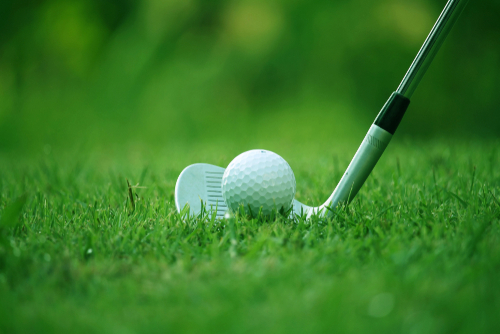How to Put Backspin on a Golf Ball
Every amateur golfer loves to watch professional golfers hit high, arcing shots that land 10 feet past the pin and then spin back to settle mere inches from the cup.
It’s thrilling to watch, but for amateur players, imparting backspin on the ball helps increase control and reliability.

While professional golfers carry skills that make creating a backspin on the ball fairly easy, weekend warriors need to maximize their swing speed and ball placement at address to increase their backspin.
In this guide to creating more backspin, we’ll give you five steps you can follow to increase your backspin while also improving your control to shorten your birdie putts.
STEP 1
Hitting the Ball First Creates More Backspin
One of the biggest problems that amateurs face when trying to improve the quality of their shotmaking is hitting the turf before striking the golf ball.
If you watch professional golfers on a driving range, the divots are tight and ahead of the golf ball because they are striking the ball first, then allowing the club face to enter the turf.
For amateurs, creating ball-first contact is essential for consistently generating backspin on the golf ball.

PRO TIP
Ball First Contact Drill
Maximum backspin comes from clean ball-first contact. The best thing that amateurs can do to generate more backspin is work on their contact quality to make sure they are striking the ball first.
A great drill for improving contact starts with a fun warm-up. Take a handful of practice swings looking to make contact with the grass a few inches behind your initial address point, then attempt to strike the grass a few inches in front of your address point.
While taking these swings, take note of the difference between how your body feels to create the forward impact point and the rear contact point. We promise it will be important when the time comes to strike the golf ball.
If you have athlete’s foot spray, make a two-foot line that runs north and south to your address point. Place the rear of the ball along that line because we want our divots to start on the front half of the line.
As you take swings with the golf ball, replicate that feeling of hitting the forward spot on the turf. That means you are pushing weight onto the front leg and moving the sternum ahead of the ball at impact.
If you are successful, your divot should start ahead of the line, and the ball will create plenty of backspin to help you control your shot as it reaches the green.
Don’t get discouraged if you continue to hit behind the line. That’s a great indicator that your weight is stuck on your back leg, and you need to work on shifting your weight forward on the downswing.
STEP 2
Make Sure You Have Sharp and Clean Grooves
Before hitting a shot, you should always check to ensure that the grooves on the face of the iron are completely clear of grime and debris. By having clean grooves, you impart the maximum amount of spin on the golf ball.
The grooves create friction against the outer layer of the golf ball at impact, forcing the ball to spin backward.
You would be surprised how many amateurs never clean their grooves while playing a round. After every shot, you need to take a brush or wet towel and remove all the debris and dirt from the grooves on the face of the iron or wedge.
There’s a reason professional golfers play with new wedges each week on tour, having new grooves at their sharpest helps maximize short game spin around the green.
STEP 3
The More Loft You Play, The More Spin You Create
For amateurs, speed remains an essential factor in producing backspin, but the club’s loft also plays a huge role.
It’s not uncommon to see professional golfers play one-club length further when they are inside 200 yards because they don’t have to swing as hard to generate the backspin they need to hold the shot on the green.
Since wedges impart the most spin on the golf ball of any club in the bag due to their high loft, amateur players need to worry more about controlling the ball with their club speed rather than worrying about the loft.
STEP 4
Swing Speed and Lie Determines Spin Rate
The better the lie, the more backspin you’ll create on the golf ball. A ball resting on the fairway will generate far more backspin than a ball sitting in light rough, no matter how well a golfer hits the ball in that situation.
If you are playing the ball from the rough or sand, opening the stance and club face can help generate more backspin.
STEP 5
Play With Higher-Quality Golf Ball
While it may seem obvious, playing with a high quality golf ball increases backspin with short irons and wedges. There’s a reason that professional golfers play with the highest priced golf balls on the market, mainly because it delivers predictable length and controllable backspin.
One of the easiest ways to increase your backspin is by purchasing a better class of golf ball. If you already play with golf balls like the Titleist ProV1 and Bridgestone Tour B XS, then you should concentrate on improving your ball-first contact to generate more back spin.

PRO TIP
Rory’s High Spin Modified Flop Shot
Rory McIlroy, widely considered one of the best short game players on the PGA Tour, utilizes a modified flop shot that creates a ton of backspin on the golf ball, helping it stop immediately on the green.
Rory’s secret involves getting square to the pin with his feet relatively close together at address. He wants his body relatively balanced, with his weight slightly forward on the inside of the lead leg.
He also doesn’t press his hands forward because he wants to maximize the loft of the wedge’s face to create backspin.
Rory doesn’t quickly hinge his wrists in the backswing, taking the club naturally back to waist high. Remember, he wants the club shaft vertical at impact to maximize the benefit of the backspin.
By pushing your hands forward and trapping the ball, you significantly reduce the spin imparted on the golf ball and the shot can actually release forward rather than stopping.
Using this shot, with either a 56-or 60-degree wedge, when you are roughly 10-15 yards from the green can help you increase control and accuracy.
Frequently Asked Questions
How do the pros put backspin on a golf ball?
A professional golfer puts backspin on the golf ball by using top-tier equipment, including playing with the best golf ball and first-rate clubs, along with utilizing their superior skill set, such as an ultra-fast swing and making contact with the golf ball well before their club face enters the soil.
If you look at a professional golfer’s divot pattern, the face’s entry point comes to a couple of inches after the impact point.
By swinging fast, making clean contact, and using the best equipment possible, professional golfers generate jaw-dropping spin rates that few amateurs could reach on their own.
How do you put backspin on a golf ball when chipping?
Using a high-lofted wedge with a loft degree of either 56 or 60 degrees can add tremendous spin to a chip shot.
Also, by opening the face of the wedge a bit at address, golfers can slide the face underneath the ball, creating more spin to help them stop shots cold near the pin when chipping around the green.
How do I get more backspin on my irons?
For golfers that want more backspin from their irons, they can do several things. The best way to generate more backspin is to increase the consistency of their ball striking. You want to hit the ball first before striking the ground. This allows the ball to come off the face cleanly.
Weekend warriors can also work on increasing their swing speed. Backspin comes from hitting the golf ball hard. If a golfer possesses a slow swing speed, they will have trouble generating shot-stopping backspin on the green.
Instead, the golf balls will release forward because there’s not enough spin to hold the shot on the putting surface.
Where do you hit the ball for backspin?
There’s no specific spot on the golf ball that you can hit to generate more backspin. Amateurs should focus on hitting the ball cleanly in the middle of the club face to create backspin.
Hitting the ground first, an inch or so behind the ball will dampen a golfer’s ability to produce distance and backspin.
How do I get more backspin on my wedges?
You can generate more spin as the face slides underneath the ball by opening your stance and opening the face of the wedge. The problem with doing this is the ball pops up and doesn’t travel very far.
However, if you are trying to clear a bunker or water around the green, an open faced wedge shot can come in quite handy, especially for golfers looking to save par.